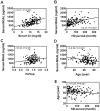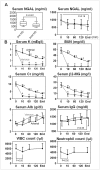Low Serum Neutrophil Gelatinase-associated Lipocalin Level as a Marker of Malnutrition in Maintenance Hemodialysis Patients
- PMID: 26161663
- PMCID: PMC4498679
- DOI: 10.1371/journal.pone.0132539
Low Serum Neutrophil Gelatinase-associated Lipocalin Level as a Marker of Malnutrition in Maintenance Hemodialysis Patients
Abstract
Background: Neutrophil gelatinase-associated lipocalin (NGAL or LCN2) is an iron-transporting factor which possesses various activities such as amelioration of kidney injury and host defense against pathogens. Its circulating concentrations are elevated in acute and chronic kidney diseases and show a positive correlation with poor renal outcome and mortality, but its clinical significance in maintenance hemodialysis (HD) patients remains elusive.
Methods: Serum NGAL levels were determined by enzyme-linked immunosorbent assay in out-patient, Japanese HD subjects. Their correlation to laboratory findings and morbidity (as development of severe infection or serum albumin reduction) was investigated using linear regression analysis and χ2 test.
Results: Pre-dialysis serum NGAL levels in HD patients were elevated by 13-fold compared to healthy subjects (n=8, P<0.001). In a cross-sectional study of 139 cases, serum NGAL concentrations were determined independently by % creatinine generation rate (an indicator of muscle mass, standardized coefficient β=0.40, P<0.001), peripheral blood neutrophil count (β=0.38, P<0.001) and anion gap (which likely reflects dietary protein intake, β=0.16, P<0.05). Iron administration to anemic HD patients caused marked elevation of peripheral blood hemoglobin, serum ferritin and iron-regulatory hormone hepcidin-25 levels, but NGAL levels were not affected. In a prospective study of 87 cases, increase in serum albumin levels a year later was positively associated to baseline NGAL levels by univariate analysis (r=0.36, P<0.01). Furthermore, within a year, patients with the lowest NGAL tertile showed significantly increased risk for marked decline in serum albumin levels (≥0.4 g/dl; odds ratio 5.5, 95% confidence interval 1.5-20.3, P<0.05) and tendency of increased occurrence of severe infection requiring admission (odds ratio 3.1, not significant) compared to the middle and highest tertiles.
Conclusion: Low serum NGAL levels appear to be associated with current malnutrition and also its progressive worsening in maintenance HD patients.
Conflict of interest statement
Figures





Similar articles
-
Neutrophil gelatinase-associated lipocalin: a novel marker of contrast nephropathy risk.Am J Nephrol. 2012;35(6):509-14. doi: 10.1159/000339163. Epub 2012 May 23. Am J Nephrol. 2012. PMID: 22627273 Clinical Trial.
-
Neutrophil gelatinase-associated lipocalin (NGAL) reflects iron status in haemodialysis patients.Nephrol Dial Transplant. 2009 Nov;24(11):3398-403. doi: 10.1093/ndt/gfp310. Epub 2009 Jun 23. Nephrol Dial Transplant. 2009. PMID: 19549696
-
Comparison of Neutrophil Gelatinase-Associated Lipocalin Versus B-Type Natriuretic Peptide and Cystatin C to Predict Early Acute Kidney Injury and Outcome in Patients With Acute Heart Failure.Am J Cardiol. 2015 Jul 1;116(1):104-11. doi: 10.1016/j.amjcard.2015.03.043. Epub 2015 Apr 8. Am J Cardiol. 2015. PMID: 25943992 Clinical Trial.
-
Neutrophil gelatinase associated lipocalin as a biomarker for acute kidney injury in patients undergoing coronary artery bypass grafting with cardiopulmonary bypass.Ann Vasc Surg. 2010 May;24(4):525-31. doi: 10.1016/j.avsg.2010.01.001. Epub 2010 Apr 2. Ann Vasc Surg. 2010. PMID: 20363104 Review.
-
Iron metabolism and regulation by neutrophil gelatinase-associated lipocalin in cardiomyopathy.Clin Sci (Lond). 2015 Nov;129(10):851-62. doi: 10.1042/CS20150075. Clin Sci (Lond). 2015. PMID: 26318828 Review.
Cited by
-
Successful management of hyperammonemia with hemodialysis on day 2 during 5-fluorouracil treatment in a patient with gastric cancer: a case report with 5-fluorouracil metabolite analyses.Cancer Chemother Pharmacol. 2020 Nov;86(5):693-699. doi: 10.1007/s00280-020-04158-1. Epub 2020 Oct 3. Cancer Chemother Pharmacol. 2020. PMID: 33011861 Free PMC article.
-
Association of plasma neutrophil gelatinase-associated lipocalin with parameters of CKD-MBD in maintenance hemodialysis patients.J Bone Miner Metab. 2021 Nov;39(6):1058-1065. doi: 10.1007/s00774-021-01248-9. Epub 2021 Aug 15. J Bone Miner Metab. 2021. PMID: 34392464
-
Bioinformatic identification of hub genes and key pathways in neutrophils of patients with acute respiratory distress syndrome.Medicine (Baltimore). 2020 Apr;99(15):e19820. doi: 10.1097/MD.0000000000019820. Medicine (Baltimore). 2020. PMID: 32282748 Free PMC article.
-
The Review of Current Knowledge on Neutrophil Gelatinase-Associated Lipocalin (NGAL).Int J Mol Sci. 2023 Jun 21;24(13):10470. doi: 10.3390/ijms241310470. Int J Mol Sci. 2023. PMID: 37445650 Free PMC article. Review.
-
Potential Biomarkers in Diagnosis of Renal Acanthamoebiasis.Int J Mol Sci. 2021 Jun 19;22(12):6583. doi: 10.3390/ijms22126583. Int J Mol Sci. 2021. PMID: 34205319 Free PMC article.
References
-
- Kjeldsen L, Johnsen AH, Sengelov H, Borregaard N. Isolation and primary structure of NGAL, a novel protein associated with human neutrophil gelatinase. The Journal of biological chemistry. 1993;268(14):10425–32. . - PubMed
-
- Goetz DH, Holmes MA, Borregaard N, Bluhm ME, Raymond KN, Strong RK. The neutrophil lipocalin NGAL is a bacteriostatic agent that interferes with siderophore-mediated iron acquisition. Molecular cell. 2002;10(5):1033–43. . - PubMed
Publication types
MeSH terms
Substances
LinkOut - more resources
Full Text Sources
Other Literature Sources
Medical
Miscellaneous

